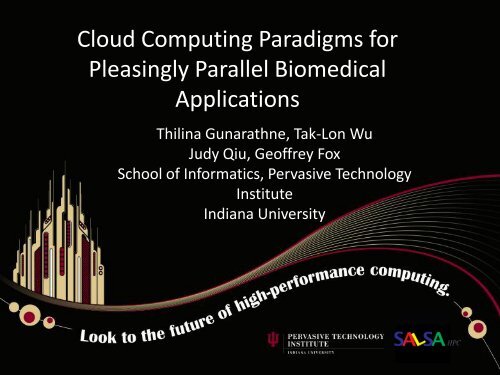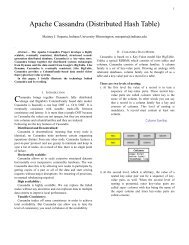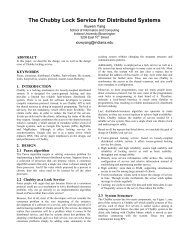slides - Salsa Group - Indiana University
slides - Salsa Group - Indiana University
slides - Salsa Group - Indiana University
You also want an ePaper? Increase the reach of your titles
YUMPU automatically turns print PDFs into web optimized ePapers that Google loves.
Cloud Computing Paradigms for<br />
Pleasingly Parallel Biomedical<br />
Applications<br />
Thilina Gunarathne, Tak-Lon Wu<br />
Judy Qiu, Geoffrey Fox<br />
School of Informatics, Pervasive Technology<br />
Institute<br />
<strong>Indiana</strong> <strong>University</strong>
Introduction<br />
• Forth Paradigm – Data intensive scientific<br />
discovery<br />
– DNA Sequencing machines, LHC<br />
• Loosely coupled problems<br />
– BLAST, Monte Carlo simulations, many image<br />
processing applications, parametric studies<br />
• Cloud platforms<br />
– Amazon Web Services, Azure Platform<br />
• MapReduce Frameworks<br />
– Apache Hadoop, Microsoft DryadLINQ
Cloud Computing<br />
• On demand computational services over web<br />
– Spiky compute needs of the scientists<br />
• Horizontal scaling with no additional cost<br />
– Increased throughput<br />
• Cloud infrastructure services<br />
– Storage, messaging, tabular storage<br />
– Cloud oriented services guarantees<br />
– Virtually unlimited scalability
Amazon Web Services<br />
• Elastic Compute Service (EC2)<br />
– Infrastructure as a service<br />
• Cloud Storage (S3)<br />
• Queue service (SQS)<br />
Instance Type<br />
Memory<br />
EC2 compute<br />
units<br />
Actual CPU<br />
cores<br />
Cost per<br />
hour<br />
Large 7.5 GB 4 2 X (~2Ghz) 0.34$<br />
Extra Large 15 GB 8 4 X (~2Ghz) 0.68$<br />
High CPU Extra Large 7 GB 20 8 X (~2.5Ghz) 0.68$<br />
High Memory 4XL 68.4 GB 26 8X (~3.25Ghz) 2.40$
Microsoft Azure Platform<br />
• Windows Azure Compute<br />
– Platform as a service<br />
• Azure Storage Queues<br />
• Azure Blob Storage<br />
Instance<br />
Type<br />
CPU<br />
Cores<br />
Memory<br />
Local Disk<br />
Space<br />
Cost per<br />
hour<br />
Small 1 1.7 GB 250 GB 0.12$<br />
Medium 2 3.5 GB 500 GB 0.24$<br />
Large 4 7 GB 1000 GB 0.48$<br />
ExtraLarge 8 15 GB 2000 GB 0.96$
Classic cloud architecture
MapReduce<br />
• General purpose massive data analysis in<br />
brittle environments<br />
– Commodity clusters<br />
– Clouds<br />
• Fault Tolerance<br />
• Ease of use<br />
• Apache Hadoop<br />
– HDFS<br />
• Microsoft DryadLINQ
MapReduce Architecture<br />
HDFS<br />
Input Data Set<br />
Data File<br />
Map()<br />
exe<br />
Map()<br />
exe<br />
Executable<br />
Optional<br />
Reduce<br />
Phase<br />
Reduce<br />
HDFS<br />
Results
Programming<br />
patterns<br />
Fault Tolerance<br />
AWS/ Azure Hadoop DryadLINQ<br />
Independent job<br />
execution<br />
Task re-execution based<br />
on a time out<br />
MapReduce<br />
Re-execution of failed<br />
and slow tasks.<br />
Data Storage S3/Azure Storage. HDFS parallel file<br />
system.<br />
Environments<br />
EC2/Azure, local<br />
compute resources<br />
Linux cluster, Amazon<br />
Elastic MapReduce<br />
DAG execution,<br />
MapReduce + Other<br />
patterns<br />
Re-execution of failed<br />
and slow tasks.<br />
Local files<br />
Windows HPCS cluster<br />
Ease of<br />
EC2 : **<br />
Programming Azure: ***<br />
Ease of use EC2 : ***<br />
Azure: **<br />
Scheduling & Dynamic scheduling<br />
Load Balancing through a global queue,<br />
Good natural load<br />
balancing<br />
**** ****<br />
*** ****<br />
Data locality, rack<br />
aware dynamic task<br />
scheduling through a<br />
global queue, Good<br />
natural load balancing<br />
Data locality, network<br />
topology aware<br />
scheduling. Static task<br />
partitions at the node<br />
level, suboptimal load<br />
balancing
Performance<br />
• Parallel Efficiency<br />
• Per core per computation time
Cap3 – Sequence Assembly<br />
• Assembles DNA sequences by aligning and<br />
merging sequence fragments to construct<br />
whole genome sequences<br />
• Increased availability of DNA Sequencers.<br />
• Size of a single input file in the range of<br />
hundreds of KBs to several MBs.<br />
• Outputs can be collected independently, no<br />
need of a complex reduce step.
Compute Time (s)<br />
Cost ($)<br />
Sequence Assembly Performance with<br />
different EC2 Instance Types<br />
2000<br />
Amortized Compute Cost<br />
Compute Cost (per hour units)<br />
Compute Time<br />
6.00<br />
5.00<br />
1500<br />
4.00<br />
1000<br />
500<br />
3.00<br />
2.00<br />
1.00<br />
0<br />
0.00
Sequence Assembly in the Clouds<br />
Cap3 parallel efficiency Cap3 – Per core per file (458<br />
reads in each file) time to<br />
process sequences
Cost to assemble to process 4096<br />
FASTA files *<br />
• Amazon AWS total :11.19 $<br />
Compute 1 hour X 16 HCXL (0.68$ * 16) = 10.88 $<br />
10000 SQS messages = 0.01 $<br />
Storage per 1GB per month = 0.15 $<br />
Data transfer out per 1 GB = 0.15 $<br />
• Azure total : 15.77 $<br />
Compute 1 hour X 128 small (0.12 $ * 128) = 15.36 $<br />
10000 Queue messages = 0.01 $<br />
Storage per 1GB per month = 0.15 $<br />
Data transfer in/out per 1 GB = 0.10 $ + 0.15 $<br />
• Tempest (amortized) : 9.43 $<br />
– 24 core X 32 nodes, 48 GB per node<br />
– Assumptions : 70% utilization, write off over 3 years,<br />
including support<br />
*<br />
~ 1 GB / 1875968 reads (458 reads X 4096)
GTM & MDS Interpolation<br />
• Finds an optimal user-defined low-dimensional<br />
representation out of the data in high-dimensional<br />
space<br />
– Used for visualization<br />
• Multidimensional Scaling (MDS)<br />
– With respect to pairwise proximity information<br />
• Generative Topographic Mapping (GTM)<br />
– Gaussian probability density model in vector space<br />
• Interpolation<br />
– Out-of-sample extensions designed to process much larger<br />
data points with minor trade-off of approximation.
Compute Time (s)<br />
Cost ($)<br />
GTM Interpolation performance with<br />
different EC2 Instance Types<br />
600<br />
500<br />
400<br />
Amortized Compute Cost<br />
Compute Cost (per hour units)<br />
Compute Time<br />
5<br />
4.5<br />
4<br />
3.5<br />
3<br />
300<br />
200<br />
100<br />
0<br />
2.5<br />
2<br />
1.5<br />
1<br />
0.5<br />
0<br />
•EC2 HM4XL best performance. EC2 HCXL most<br />
economical. EC2 Large most efficient
Dimension Reduction in the Clouds -<br />
GTM interpolation<br />
GTM Interpolation parallel<br />
efficiency<br />
GTM Interpolation–Time per core<br />
to process 100k data points per<br />
core<br />
•26.4 million pubchem data<br />
•DryadLINQ using a 16 core machine with 16 GB, Hadoop 8 core with 48 GB, Azure small<br />
instances with 1 core with 1.7 GB.
Dimension Reduction in the Clouds -<br />
MDS Interpolation<br />
• DryadLINQ on 32 nodes X 24 Cores cluster with 48 GB per node. Azure using small<br />
instances
Next Steps<br />
• AzureMapReduce AzureTwister
Alignment Time (ms)<br />
AzureMapReduce SWG<br />
SWG Pairwise Distance 10k Sequences<br />
7<br />
6<br />
Time Per Alignment Per Instance<br />
5<br />
4<br />
3<br />
2<br />
1<br />
0<br />
0 32 64 96 128 160<br />
Number of Azure Small Instances
Conclusions<br />
• Clouds offer attractive computing paradigms for<br />
loosely coupled scientific computation applications.<br />
• Infrastructure based models as well as the Map Reduce<br />
based frameworks offered good parallel efficiencies<br />
given sufficiently coarser grain task decompositions<br />
• The higher level MapReduce paradigm offered a<br />
simpler programming model<br />
• Selecting an instance type which suits your application<br />
can give significant time and monetary advantages.
Acknowlegedments<br />
• SALSA <strong>Group</strong> (http://salsahpc.indiana.edu/)<br />
– Jong Choi<br />
– Seung-Hee Bae<br />
– Jaliya Ekanayake & others<br />
• Chemical informatics partners<br />
– David Wild<br />
– Bin Chen<br />
• Amazon Web Services for AWS compute credits<br />
• Microsoft Research for technical support on<br />
Azure & DryadLINQ
• Questions?<br />
Thank You!!








